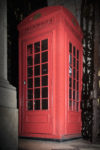 The first of the iconic red telephone boxes has gotten an upgrade in its protection listing from Grade II (of special interests) to Grade II* (particularly important building of more than special interest).
The first of the iconic red telephone boxes has gotten an upgrade in its protection listing from Grade II (of special interests) to Grade II* (particularly important building of more than special interest).
Heritage Minister Helen Whately said:
“The red telephone box is an internationally famous British icon and I am delighted that we are able to protect the first of its kind.
In an increasingly digital world, it is important to preserve structures – like the K2 prototype phone box – that have played a part in our nation’s industrial story.”
The General Post Office’s first public telephone box, the concrete Kiosk No. 1 (K1), introduced in 1921, was rejected by London’s local councils, so in 1924 the Royal Fine Arts Commission asked architect Sir Giles Gilbert Scott and two other highly respected architects (Sir Robert Lorimer and Sir John Burnet) to submit designs for a new and improved phone kiosk. Five prototypes were manufactured and displayed outside the National Gallery in Trafalgar.
 Scott, a trustee of the Sir John Soane’s Museum, drew inspiration from the domed canopy of the tomb Soane designed for his beloved and much-lamented wife Eliza in the churchyard of St. Pancras Old Church, London. The prototype with its curved dome was made of timber. After judging the K2 prototype was moved to Burlington House, home of the Royal Academy, where it remains to this day.
Scott, a trustee of the Sir John Soane’s Museum, drew inspiration from the domed canopy of the tomb Soane designed for his beloved and much-lamented wife Eliza in the churchyard of St. Pancras Old Church, London. The prototype with its curved dome was made of timber. After judging the K2 prototype was moved to Burlington House, home of the Royal Academy, where it remains to this day.
In 1925, Scott’s design for the prototype K2 (Kiosk No.2) telephone box was chosen as the “most suitable for erection in busy thoroughfares of large towns.” Scott had planned for the finished booths to be made of steel with blue-green interior. The General Post Office decided to go with cast iron painted red.
After the successful competition, the first cast iron K2 was installed in London in 1926, with more than 1,700 appearing across the city over the course of the next decade. Only a small number were placed outside London and just over 200 K2s survive today. The K2 was replaced in 1935 by the streamlined, more compact and cost-effective K6 model which was also designed by Scott and is the most common red telephone box still in existence today.